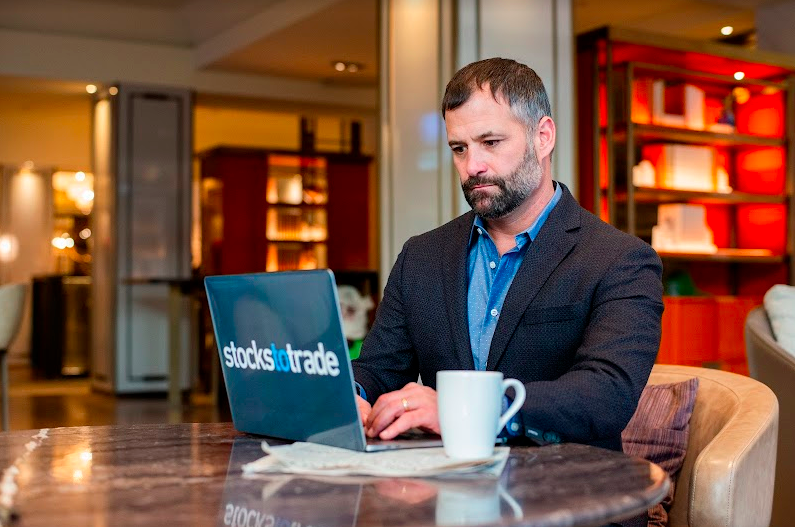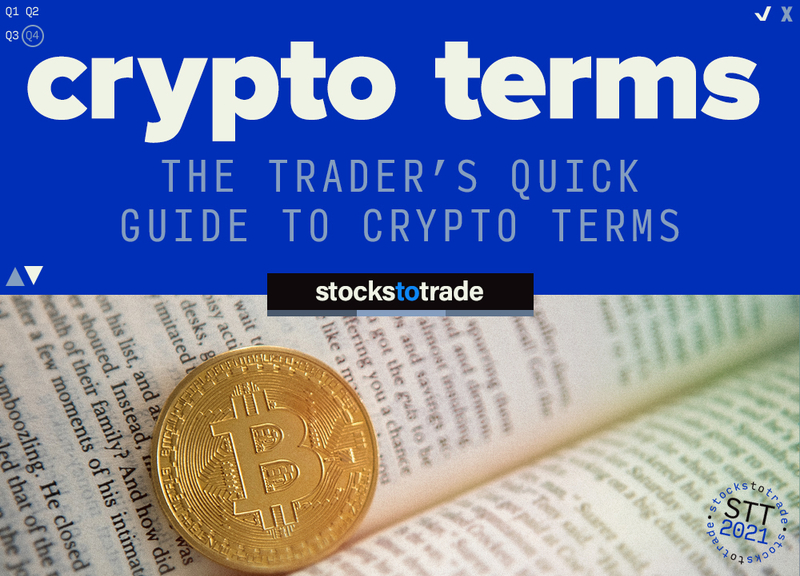Crypto Terms: Key Takeaways
- Crypto terminology shares a lot of overlap with the WallStreetBets crowd…
- Some of the terms you need to know are on the technical side, like DeFi and proof-of-stake…
- Others will help you make sense of the forums, so you don’t go ‘apeing’ after every new coin!
Check out my top crypto stocks to watch here!
Crypto traders have their own language, so learning the right crypto terms is essential.
If you want to understand crypto culture, treat these terms as your ABCs.
Table of Contents
- 1 What Newbies Already Know
- 2 The Crypto Dictionary
- 2.1 Address
- 2.2 Altcoin
- 2.3 Blockchain
- 2.4 CEX
- 2.5 Coinbase
- 2.6 Consensus
- 2.7 DeFi
- 2.8 DEX
- 2.9 Exit Scam
- 2.10 Fiat
- 2.11 Fork
- 2.12 Hash Rate
- 2.13 ICO
- 2.14 Mining
- 2.15 Private Key
- 2.16 Proof-of-Stake (PoS)
- 2.17 Proof-of-Work (PoW)
- 2.18 Public Key
- 2.19 Simple Agreement for Future Tokens (SAFT)
- 2.20 Stablecoin
- 2.21 Staking
- 2.22 Token
- 2.23 Token Burning
- 2.24 Uniswap
- 2.25 Wallet
- 3 Crypto Slang
- 4 How Do You Trade Crypto?
- 5 Conclusion
What Newbies Already Know
First of all, they spell it ‘n00b’ in crypto land.
That’s because crypto and computer culture have a good amount of overlap. If you already understand computer-speak, you’re ahead of the game!
It’s the same way for us traders…
At least those of us paying attention in the Reddit era. Since then, ‘HODL’ and ‘diamond hands’ have become common terms…
HODL got its start in a crypto forum in 2013. Diamond hands is a WallStreetBets original.
It doesn’t matter. They’re both part of this extremely online culture.
Study up or you’ll get left behind.
The Crypto Dictionary

© StocksToTrade
First, we’ll cover the technical side…
Address
Blockchain addresses are your coordinates for receiving, sending, and storing crypto. Every address is unique and represents a wallet on the blockchain.
Altcoin
Matt Monaco calls altcoins the penny stocks of the crypto markets…
Altcoins are cryptocurrencies that aren’t Bitcoin (and in some cases, Ether). They have small market caps, and the possibility for huge returns.
Blockchain
Blocks record crypto transactions, like a page in an old-timey ledger. The blockchain connects the blocks in sequence. It is a digital ledger of all the verified transactions made with a cryptocurrency.
CEX
CEXs (Centralized Exchanges) are platforms like Coinbase that allow traders to buy and sell cryptocurrencies. They maintain their own order books, promising greater security and a better user experience than DEXs. They also operate under regulatory supervision.
Coinbase
Coinbase is one of the largest crypto exchanges out there, and supposedly one of the safest. Its IPO was a big moment in the crypto stock sector.
Consensus
Since crypto is decentralized, it doesn’t have a central authority like a bank approving transactions. The way it makes sure transactions are honest is through consensus. Two of the most popular processes are proof-of-work (PoW) and proof-of-stake (PoS).
DeFi
DeFi (Decentralized Finance) isn’t just about decentralized currencies (all crypto). It’s also about decentralizing transactions, which is the entire idea that crypto is based on.
DEX
DEXs (Decentralized Exchanges) are peer-to-peer crypto marketplaces. They don’t have a middleman, which allows for greater anonymity. Traders here are responsible for their own security.
Exit Scam
Crypto isn’t as sketchy as it used to be…
It isn’t fully safe either.
One of the biggest cons is the Exit Scam. This is when crypto developers put together an ICO — then leave with the money.
Its cousin is the Rug Pull. This is what happened with the Squid Game crypto…
These creeps drain the project of liquidity, making it untradeable. Then they leave with the money.
Fiat
Have you ever heard a crypto bull talking about the ‘problem’ that crypto solves? Chances are it has something to do with fiat currency.
Fiat describes government-issued currencies like the US dollar — which only has value because the government says so.
Fork
A fork happens when a cryptocurrency splits into two separate projects. With soft forks, only one blockchain protocol remains operational. Hard forks create two new cryptocurrencies — most famously in the case of Bitcoin and Bitcoin Cash.
Hash Rate
Hash rate refers to the computing power used in crypto mining.
It isn’t only useful for mining new coins though. The higher the overall hash rate, the better the blockchain’s security.
ICO
You know how I warn you to exercise caution with IPOs? ICOs (initial coin offerings) have the same uncertainty — on steroids.
Many ICOs are classic pump schemes. See also: Exit Scam.
Mining
Crypto mining is the engine that makes this whole thing run! Miners solve math problems with their powerful computers. The goal is unlocking new coins, but they are also validating crypto transactions at the same time.
Private Key
This is basically your crypto password.
Proof-of-Stake (PoS)
It’s not what you’re thinking…
PoS is a method of consensus and mining. The ability to mine and validate transactions here is based on the number of coins held. This system is safer than PoW, as miners with more power also have more at stake. It’s also less energy intensive.
This is the process that Ethereum uses.
Proof-of-Work (PoW)
PoW is the method of validation Bitcoin uses. It uses an incredible amount of energy — which rises as the Bitcoin supply dwindles. According to the Bitcoin Energy Consumption Index, a single Bitcoin transaction takes more energy than is needed to power the average US household for 68 days!
This power consumption is one of the main reasons that future thinkers like Elon Musk have been critical of Bitcoin.
Public Key
This is your wallet address. You give it to other people to receive crypto from them.
Simple Agreement for Future Tokens (SAFT)
SAFTs are the crypto world’s private placements and a counterpoint to ICOs. Like private placements, SAFTs allow crypto startups to raise money from select investors. In return, the investors can receive discounted coins at a later date.
Stablecoin
A stablecoin is a cryptocurrency whose value is pegged to another source, like gold or the US dollar. Tether, USD Coin, and Binance USD are among the most popular.
Staking
Staking is a way for crypto holders to earn rewards in a PoS system. Small account holders can dedicate their coins to the staking pool to help verify transactions. Larger accounts can become full validators through the use of dedicated computers. This comes with a larger set of security concerns.
In return for staking, you receive generous interest payments and voting rights. A big downside is the need to lock up your crypto for a set amount of time.
Token
The words ‘token’ and ‘coin’ are mostly used interchangeably. Some people define a coin as crypto that runs on its own blockchain, like Bitcoin or Ethereum. Tokens run on other coins’ blockchains.
Token Burning
Token burning is the act of sending coins to a wallet without an address, making them inaccessible. This decreases the supply.
Uniswap
Uniswap is the largest DEX operating on the Ethereum blockchain.
Wallet
Crypto wallets can be physical devices or computer programs. Through the use of public and private keys, wallets give access to specified crypto stored on the blockchain.
Crypto Slang
Now let’s explore the culture…
Apeing
Apeing is more derogatory in the world of crypto than it is on Reddit. Here, it refers to buying new tokens without first doing research.
ATH
ATH stands for all-time high… This is something traders say all the time, just abbreviated.
BTFD
This is one of our favorite strategies on the SteadyTrade Team. We’re just a bit more polite about it.
Diamond Hands/Weak Hands
This is one of the things I like least about the new school of traders.
If you’re new here, you should know that it isn’t brave to stay in a trade when it goes against you. Sure, sometimes it works out. But that’s no way to build a trading career.
Diamond Hands refers to traders who hold onto crypto positions when they’re falling. Weak Hands refers to those who sell. Both are appropriate strategies at times. Want to know when? Consult your trading plan.
DYOR
Do your own research.
HODL
Switch the ‘D’ and ‘L’…
This is something traders with Diamond Hands often do.
Lambo
When crypto traders ask “When Lambo?” they’re asking when a coin’s price will increase enough to buy a Lamborghini.
How Do You Trade Crypto?

© StocksToTrade
I always remind SteadyTrade Team members that there are no sure things on the market…
That applies 1,000% to the world of crypto.
Stock markets open and close at certain hours.
Crypto trades 24 hours a day…
7 days a week…
52 weeks a year.
You need different strategies to trade these unpredictable markets. That’s why Matt Monaco and Kyle Williams’ new crypto program is so valuable.
It’s called Crypto Rockets. It’s Matt and Kyle’s entire crypto strategy — in one place.
Get the most comprehensive crypto trading membership out there — right here.
Conclusion
At its core, crypto is about secure communication. Computers already know the lexicon — you need to learn it too.
Even if you don’t trade crypto, it’s a handy thing to know.
Trade it or not, crypto has become a big part of the trading world. The total market for all crypto is now over $3 trillion. That puts it around the same size as the London Stock Exchange.
It’s grown $1 trillion since April 2021. Chances are it’s going to become an even bigger part of the trading world.
How many of these words did you know? What’s your favorite crypto slang term? Let me know in the comments!
